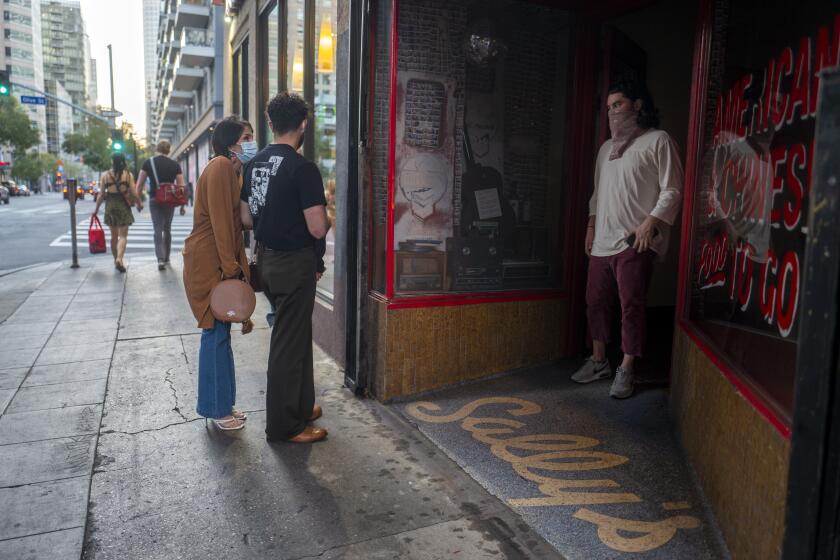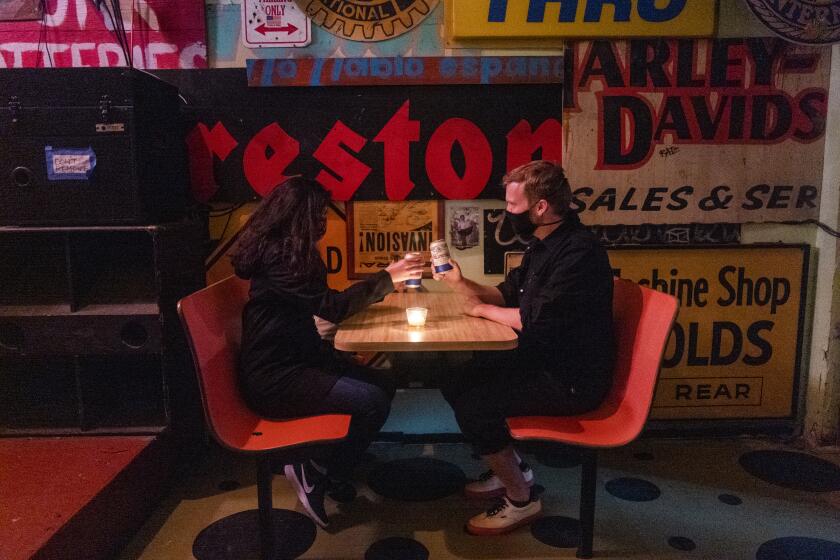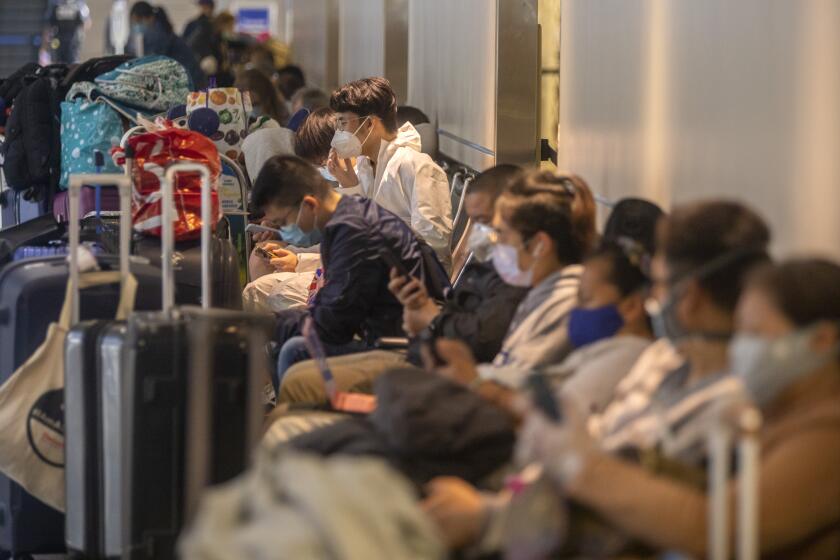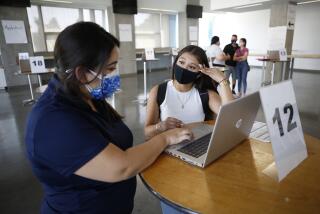California nears COVID-19 vaccine target that would ease more reopening rules
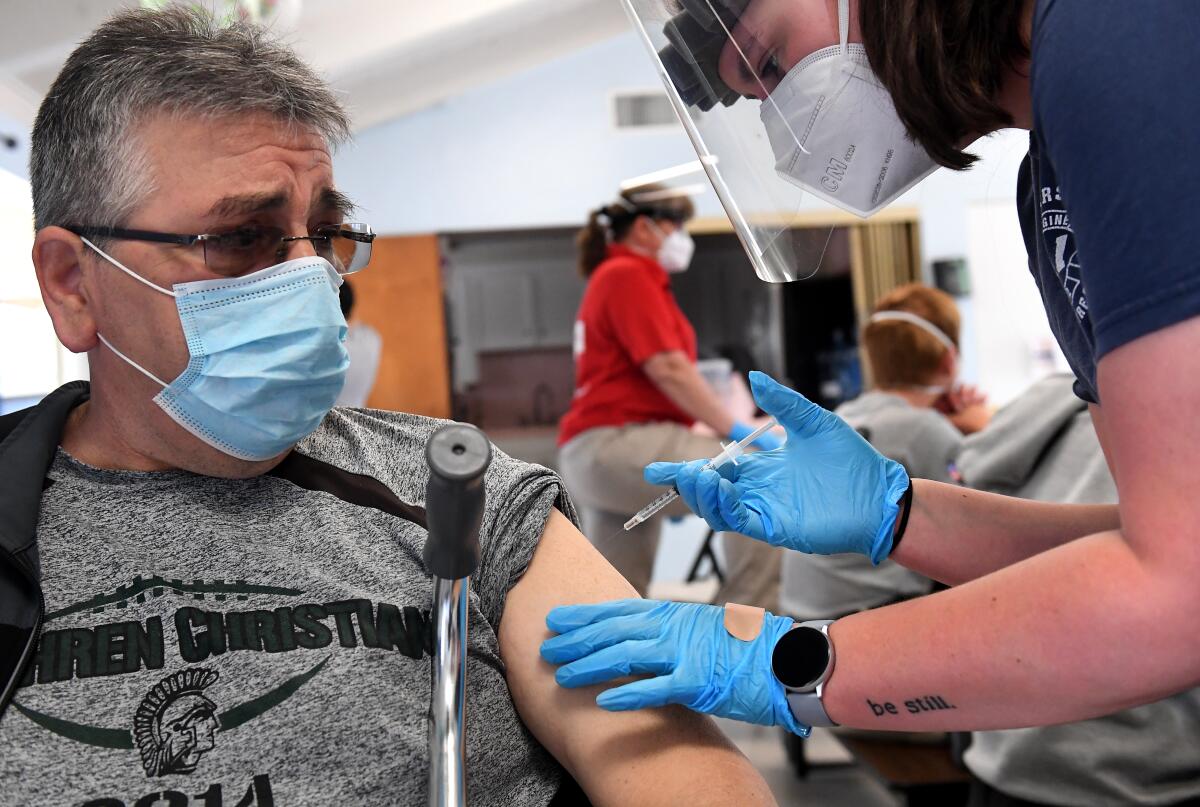
- Share via
California is on the precipice of administering 4 million COVID-19 vaccine doses in its most disadvantaged areas — a hurdle that, when cleared, would trigger a rewrite of the state’s reopening blueprint to make it easier for counties to more widely reopen businesses and other public spaces.
State data show that, as of Monday, providers had doled out 3.93 million doses in the targeted communities, which fall within the lowest quartile of a socioeconomic measurement tool called the California Healthy Places Index.
On reaching 4 million doses, California will relax one of the metrics necessary for counties to progress into the lower tiers of its four-rung reopening roadmap.
L.A. County will relax more pandemic restrictions when it moves into the orange tier, the second-most-lenient of the state’s four-phase reopening plan.
As it stands now, counties have to record a coronavirus case rate — adjusted based on the number of tests performed — of below 4.0 new cases per day per 100,000 people to move into the second-least-restrictive orange tier. When the blueprint is revised, the requirement would be loosened to under 6.0.
Entering the most lenient yellow tier would necessitate an adjusted daily new case rate below 2.0 per 100,000 people, compared with the current requirement of less than 1.0.
The other two data points used to determine tier assignments — the rate of positive test results and a health-equity metric intended to ensure that the positive test rate in poorer communities is not significantly higher than the county’s overall figure — would remain unchanged.
While the imminent revision to California’s reopening roadmap won’t affect those counties that have already moved into the orange or yellow tiers — a club that now includes Los Angeles, Orange, Santa Clara and San Francisco — it would make it easier for them to avoid potentially backsliding, should their coronavirus case rates creep up a bit.
The changes would, however, position some areas to enter the orange tier more rapidly.
Typically, counties need to record two straight weeks of qualifying data to advance to a less-restrictive tier and must remain in a tier for at least three weeks before moving again.
However, revising the blueprint can muddy that timeline. When the state met its initial goal of administering 2 million vaccines in the hardest-hit and most disadvantaged areas last month, the revised metric that went into effect — which made it easier for counties to exit the state’s most proscriptive purple tier — applied retroactively.
That meant counties were allowed to move forward if they had two weeks’ worth of qualifying data under the new metric.
In other words, if a county is already within the new range of what would be considered the orange tier, then it could potentially advance to that level as soon as this week, provided its numbers hold steady.
New tier assignments will be announced Tuesday.
Bars in L.A. County that don’t serve food can reopen Monday, outdoors only and at limited capacity. Some prepare to reopen, while other venues wait.
As counties advance through the tier framework, they can gradually lessen restrictions.
On reaching the orange tier, counties can allow bars to reopen outdoors with some modifications, and bars also are no longer required to serve food.
Amusement parks can reopen at up to 25% capacity, and fan attendance is allowed at 33% capacity for outdoor sports and live performances.
Capacity restrictions can also be lifted in stores, although social distancing and other safety modifications still apply; houses of worship, museums, zoos and aquariums can raise their indoor capacity to 50% from 25%; restaurants and movie theaters can raise indoor capacity to 50% capacity or 200 people from 25% or 100 people (whichever is fewer); and indoor gyms and yoga studios can increase capacity to 25% from 10%.
Bowling alleys can reopen with modifications at 25% capacity. Card rooms and satellite wagering sites can also reopen indoors at 25% capacity.
Offices in nonessential industries can also reopen, though the state says workers should still be encouraged to work remotely.
Nationally, there has been an 8% week-over-week increase in the average daily number of new coronavirus cases, with much of the increase in Michigan, the New York region and New England. Experts are uncertain if it will remain contained.
For the last month, California has devoted 40% of its COVID-19 vaccine supply to residents in the state’s most disadvantaged areas — a strategy officials said would help address inequities that have persisted throughout the inoculation campaign, as well as make sure those most at risk of the coronavirus have access to the shots.
However, disparities still linger. The number of doses administered in targeted communities is 578,000 less than any other HPI quartile, state data show. By comparison, more than 5.8 million vaccines have been provided in the highest-quartile areas.
Providers throughout California have doled out almost 20 million total vaccine doses to date, according to figures from the U.S. Centers for Disease Control and Prevention, and 33.6% of residents have received at least one dose.
Roughly 17.8% of Californians are fully vaccinated.
More to Read
Sign up for Essential California
The most important California stories and recommendations in your inbox every morning.
You may occasionally receive promotional content from the Los Angeles Times.
